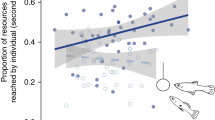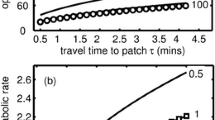Abstract
Foraging theory has been widely used to understand patterns associated with obtaining resources and the optimal cost-benefit relationship between forager and resource. However, many analytical theoretical models do not consider the influence of social groups on forager strategy. We analyzed strategies for obtaining resources from two perspectives: individual and social. For the first, we tested hypotheses that addressed whether individual strategies followed the predictions of classic models of foraging theory. In the second approach, we investigated potential social influences on resource-obtaining strategies. Our results suggest that regardless of the strategy adopted by the forager (specialist or generalist), environmental factors, such as abundance, regulated success in obtaining resources. However, we observed that specialists had a greater advantage relative to generalists when resources were abundant. We also observed that forager decision-making was related to the social context of the individual forager, which influenced their strategies.


Similar content being viewed by others
Notes
That is, the first participant identifies other potential participants, who in turn identify further participants until no new identifications emerge.
References
Albuquerque, F. J. A., Pimentel Neto, J. G., and Galvíncio, J. D. (2007). Análise da cobertura da terra em função da precipitação mensal (janeiro e outubro de 2006) utilizando imagens CBERS para o município de Ouricuri – PE. Revista de Geografia 24(1): 6-18.
Albuquerque, U. P., Ramos, M. A., Lucena, R. F. R., and Alencar, N. L. (2014). Methods and techniques used to collect ethnobiological data. In Albuquerque, U. P., Cunha, L. V. F. C., Lucena, R. F. P., and Alves, R. N. N. (Orgs.), 2014, Methods and Techniques in Ethnobiology and Ethnoecology, Humana Press, New York, pp. 15-37.
Ayres, M., Ayres, M. Jr., Ayres, D. L., and Santos, A. S. (2007). BioEstat 5.0: Aplicações estatísticas nas áreas das ciências biomédicas, Sociedade Civil de Mamirauá, Belém, Brasil, p. 380.
Bailey, K. D. (1978). Methods of Social Research, The Free Press, New York.
Barbosa, WF. Sousa, EP. (2011). Nível tecnológico e seus determinantes na apicultura da microrregião do cariri – CE. In: VII Encontro Economia do Ceará em Debate. (2011). Instituto de Pesquisa e Estratégia Econômica do Ceará (IPECE). Fortaleza, Ceará. 23p.
Begossi, A. (1993). Ecologia humana: um enfoque das relações homem-ambiente. Interciência 18(3): 121–132.
Borgatti, S. P., and Natick, M. A. (1996). Anthropac 4.0: Analytic Technologies, Natick, Massachusetts.
Bowers, J. E. (2007). Has climatic warming altered spring flowering date of Sonoran Desert shrubs? Southwestern Naturalist 52(3): 347–355.
Boyd, R., and Richerson, P. J. (2005). The origins of evolution of human culture, Oxford University Press, Oxford.
CPRM (Serviço Geológico do Brasil). (2005). Projeto cadastro de fontes de abastecimento de água subterrânea. In Mascarenhas, J. C., Beltrão, B. A., Souza Júnior, L. C., Galvão, M. J. T. G., Pereira, S. N., and Miranda, J. L. F. (eds.), Diagnóstico do município de Moreilândia, estado de Pernambuco, CPMR/PRODEEM, Recife.
Delton, A. W., and Robertson, T. E. (2012). The social cognition of social foraging: partner selection by underlying valuation. Evolution and Human Behavior 33: 715–725.
EMBRAPA (Empresa Brasileira de Agropecuária). (2009). Multiplicação de colônias de abelhas africanizadas (Apis mellifera). Projeto “Consolidação da apicultura como estratégia para a geração de rendaem assentamentos rurais de Corumbá”. Ministério da Agricultura, Pecuária e Abastecimento. Corumbá, Minas Gerais. Novembro de 2009.
Freeman, J., Anderies, J. M., Torvinen, A., and Nelson, B. A. (2014). Crop Specialization, Exchange and Robustness in a Semi-arid Environment. Human ecology 42(2): 297–310.
Giraldeau, L., and Caraco, T. (2000). Social Foraging Theory, Princeton University Press, Princeton, p. 376.
Giraldeau, L., Valone, T. J., and Templeton, J. J. (2002). Potential disadvantages of using socially acquired information. Philosophical Transactions of the Royal Society B 357: 1559–1566.
Heinrich, J., and Gal-White, F. J. (2001). The evolution of prestige Freely conferred deference as mechanism for enchancing the benefits of cultural transmission. Evolution and Human Behavior 22(2001): 165–196.
Hutchinson, J. M. C., Wilke, A., and Todd, P. M. (2008). Patch leaving in humans: can a generalist adapt its rules to dispersal of items across patches? Animal Behaviour 75: 1331–1349.
IICA (Instituto Interamericano de Cooperação para a Agricultura). (2012). Apoio a iniciativas locais de combate à desertificação. Available in http://www.iicabr.iica.org.br/wp-content/uploads/2014/03/Livro_CombateDesertificacao_web.pdf. Acessed in 20.01.2015.
Ladio A., and Lozada, M. (2003). Comparison of wild edible plant diversity and foraging strategies in two aboriginal communities of northwestern Patagonia. Biodiversity and Conservation 12: 937–951.
Lopes, H. L., Candeias, A. L. B., Accioly, J. O. L., Sobral, M. C. M., and Pacheco, A. P. (2010). Parâmetros biofísicos na detecção de mudanças na cobertura e uso do solo em bacias hidrográficas. Revista Brasileira de Engenharia Agrícola e Ambiental 14(11): 1210–1219.
MacArthur, R. H., and Pianka, E. R. (1966). On optimal use of a patch environment. The American Naturalist 100(916): 603–609.
Matsumoto, T., and Yamazaki, K. (2013). Distance of migratory honey bee apiary effects on the community of insects visiting flowers of pumpkin. Bulletim of Insectology 66(1): 103–108.
Mauritz, M., Cleland, E., Merkley, M., and Lipson, D. A. (2014). The influence of altered rainfall regimes on early season N partitioning among early phenology annual plants, a late phenology shrub, and microbes in a semi-arid ecosystem. Ecosystems 17: 1354–1370.
Mesoudi, A. (2011). Cultural Evolution: how Darwinian theory can explain human culture and synthetize the social sciences, The University of Chicago Press, Chicago, p. 186.
Mesoudi, A., Whiten, A., and Laland, K. (2006). Towards a unified science of cultural evolution. Behavioral and Brain Sciences 29: 329–383.
Pierce, G. L., and Ollason, J. G. (1987). Eight reasons why optimal foraging theory is a complete waste of time. Oikos 49: 111–118.
Pyke, G. H. (1984). Optimal foraging theory: a critical review. Annual Review of Ecology and Systematics 15: 523–575.
R: A language and environment for statistical computing. R Foundation for Statistical Computing, Vienna, Austria. URL https://www.R-project.org/.
Ragusa-Netto, J., and Silva, R. R. (2007). Canopy phenology of a dry forest in western Brazil. Brazilian Journal of Biology 67(3): 569–575.
Rendell, L., Fogarty, L., and Laland, K. N. (2009). Rogers’ paradox recast and resolved: population structure and the evolution of social learning strategies. Evolution 64(2): 534–548. doi:10.1111/j.1558-5646.2009.00817.x.
Richardson, A. D., Keenan, T. F., Migliavacca, M., Ryu, Y., Sonnentag, O., and Toomey, M. (2013). Climate change, phenology, and phenological control of vegetation feedbacks to the climate system. Agricultural and Forest Metereology 169(2013): 156–173.
Richerson, P. J., and Boyd, R. (2005). Culture is Maladaptative. In: Richerson, P. J., and Boyd, R. (Orgs.), (2005). Not by genes alone: how culture transformed human evolution, The University of Chicago Press, Chicago and London, pp. 148-190.
Sá, I. I. S., Galvíncio, J. D., Moura, M. S. B., and Sá, I. B. (2010). Cobertura vegetal e uso da terra na região Araripe pernambucana. Mercator 9(19): 143–163.
Santos, L. L., Vieira, F. J., Nascimento, L. G. S., Silva, A. C. O., Santos, L. L., Souza, G.M. (2014). Techniques for collecting and processing plant material and their application in ethnobotany research. In Albuquerque, U. P., Cunha, L. V. F. C., Lucena, R. F. P., and Alves, R. N. N. (Orgs.), 2014. Methods and Techniques in Ethnobiology and Ethnoecology, Humana Press, New York, pp. 161-174.
Silva, N. A. (2004). Aspectos do perfil do conhecimento de apicultores sobre manejo e sanidade da abelha africanizada em regiões de apicultura de Santa Catarina. (Dissertação de Mestrado), Pós-Graduação em Agrossistemas. Universidade Federal de Santa Catarina, Florianópolis, Santa Catarina, p. 128.
Silva, R. H. D., and Freitas, B. M. (2004). Produção e desenvolvimento de colônias de abelhas africanizadas (Apis melífera L.) a partir de diferentes áreas e idades de cria. Ciência Rural, Santa Maria 34(2): 545–594.
Smith, E. A. (1983). Anthropological applications of optimal foraging theory: a critical review. Current Anthropology 24(5): 625–651.
Smith, C. L., and McKelvey, R. (1986). Specialist and generalist: roles for coping with variability. North American Journal of Fisheries Management 6: 88–99.
Soldati, G. T., and Albuquerque, U. P. (2012). A new application for the optimal foraging theory: the extraction of medicinal plants. Evidence-Based Complementary and Alternative Medicine 2012: 364564.
Soldati, G. T., Hanazaki, N., Crivos, M., and Albuquerque, U. P. (2015). Does environmental instability favor the production and horizontal transmission of knowledge regarding medicinal plants? A study in Southeast Brazil. Plos One. doi:10.1371/journal.pone.0126389.
Trindade, M. S. A., Sousa, A. H., Vasconcelos, W. E., Freitas, R. S., Silva, A. M. A., Pereira, D. S., and Maracajá, P. B. (2004). Avaliação da polinização e estudo comportamental de Apis mellifera L. na cultura do meloeiro em Mossoró, RN. Revista de Biologia e Ciências da Terra 4(1): 01–10.
Webster, M. M., and Laland, K. N. (2012). Social information, conformity and opportunity costs paid by foraging fish. Behav Ecol Sociobiol. doi:10.1007/s00265-012-1328-1.
Wilke, A., Hutchinson, J. M. C., Todd, P. M., and Czienkowski, U. (2009). Fishing for the right words: decision rules for human foraging behavior in internal search tasks. Cognitive Sciences 33(2009): 497–529.
Winterhalder, B. (1990). Open field, common pot: Harvest variability and risk avoidance in agricultural and foraging societies. In Cashdan, E. 1990. Risk and uncertainty in tribal and peasant economies, pp. 67-87.
Wiston, M. L. (1992). The biology and management of Africanized Honey Bees. Annual Review of Entomology 37: 173–193.
Acknowledgements
The authors thank the Rural Federal University of Pernambuco and the Graduate Program in Ethnobiology and Nature Conservation for the institutional support for the development of this research; the funding institution Foundation for Science and Technology of the State of Pernambuco (Fundação de Amparo à Ciência e Tecnologia de Pernambuco – FACEPE) for the scholarship assigned to the first author; the Laboratory of Ecology and Evolution of Social-ecological Systems (LEA) and Reproductive Ecology Laboratory Flowering Plants (LERA), both based in the UFRPE, for their support at all stages of the study; ICMBio for the necessary authorization for this study in the Environmental Protection Area of Araripe (Araripe-EPA); and the itinerant beekeepers from the communities studied and managers of the Moreilândia Association of Beekeepers (APIM) for the logistical support, responsiveness and shared knowledge.
Author information
Authors and Affiliations
Corresponding author
Ethics declarations
For our initial research, authorization was requested from the Research Ethics Committee (REC) of the Federal University of Pernambuco (UFPE) in accordance with Resolution no. 466/2012 of the National Health Council. With this authorization, to meet the requirements of the resolution, the research objectives were explained to the beekeepers involved in the study before they signed an Informed Consent (IC) to authorize the use of forms and allow interviews. Because the study region is within an Environmental Protection Area (Araripe-EPA), authorization for the survey was obtained from the ICMBio through the Authorization and Information on Biodiversity System (SISBIO) under no. 38021–1.
Conflicts of Interest
The authors declare that they have no conflicts of interest.
Rights and permissions
About this article
Cite this article
Alves, A.S.A., do Nascimento, A.L.B., Albuquerque, U. et al. Optimal Foraging Theory Perspectives on the Strategies of Itinerant Beekeepers in Semiarid Northeast Brazil. Hum Ecol 45, 345–355 (2017). https://doi.org/10.1007/s10745-017-9909-2
Published:
Issue Date:
DOI: https://doi.org/10.1007/s10745-017-9909-2




